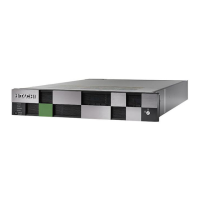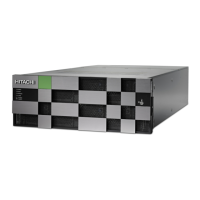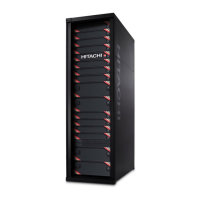6. Open Stor
age Navigator and recongure L
UN mapping and host group on the
storage system that is dedicated to the server with the new WWPNs. Perform this
step for every aected server port.
7. If the server does not recognize the system drives, enter fc-link-reset to reset
the ber paths.
8. Enter sdpath to display the path to the devices (system drives) and which hport and
stor
age port are used.
9. Enter sd-list to verify the system drives statuses as OK and access is allowed.
10. Enter span-list to verify the storage pools (spans) are accessible.
Note: In this instance, cluster is synonymous with the standalone server.
11. Enter span-list-cluster-uuids span_label to display the cluster serial
number (UUID) to which the stor
age pool belongs.
The UUID is written into the stor
age pool’s conguration on disk (COD). The COD is a
data structure stored in every SD, which provides information how the dierent SDs
are combined into dierent stripesets and storage pools.
12. Enter span-assign-to-cluster span_label to assign all the spans to the new
server.
13. Verify the IP routes, and enable all the EVSs for le services in case they are
disabled.
14. Recongure any required tape backup application security.
15. Navigate to Home > Status & Monitoring >
Event Logs, and click Clear Event
Logs.
16. Navigate to Home > Status & Monitoring > System Monitor and verify the server
status:
■ If the server is operating normally, and is not displaying any alarm conditions,
run a backup to capture the revised conguration, and then download another
diagnostic to support. Permanent license keys for the replacement server are
normally provided within 7 days.
■ If the server is not operating normally for any reason, contact support for
assistance.
17. Conrm all nal settings, IP addresses, customer contact information, service
restarts, client access, and that customer expectations are all in place. Features such
as replication and data migration should all be conrmed as working, and all le
systems and storage pools should be online.
Replacing a node within a cluster
Replacing a single node within a cluster assumes only two-node clusters and the
presence of an external SMU, which acts as a quorum device. This helps to simplify the
replacement process because a cluster preserves operational state of the entire system
beyond any single node failure.
Replacing a node within a cluster
Appendix A: Server replacement procedures
Hitachi NAS Platform and Hitachi Unied Storage Series 4000 Hardware Reference 109

